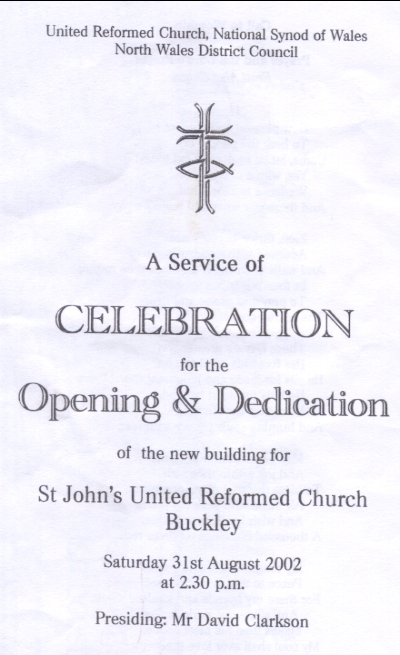
Programme of the service of dedication for the new Saint John's United Reformed Church"

Saint John's United Reformed Church, Buckley
31 August 2002
The text was reproduced in "COMMON INTEREST - THE MAGAZINE OF ST. JOHN'S UNITED REFORMED CHURCH, BUCKLEY: CHRISTMAS 2002"
THE EARLY HISTORY OF ST. JOHN'S UNITED REFORMED CHURCH, BUCKLEY
PRESENTED BY DON DONNELL AT THE OPENING AND DEDICATION SERVICE OF THE NEW BUILDING ON SATURDAY 31ST AUGUST 2002 (see main entry in this reminiscence list - ed.)
At this particular moment in time, as we contemplate our beautiful new house of worship, we must register our gratitude to all who have made this day possible.
For some years, within our church family, a great deal of debate and heart searching took place regarding the wisdom of demolishing our old building and replacing it with a modern structure designed to suit our future needs. Today I feel that, without exception, we are all in agreement that our decision to redevelop was correct. Let us not however get carried away with the thought that our decision has been unique, but rather take a peep over our shoulder at the many obstacles and set backs encountered by our fore-bearers during the long history of St. John's.
Our founder, Jonathan Catherall, was born into one of our leading industrial families in the mid 18th century. The name Jonathan had been passed from father to son over many generations, so let us, as a church family, do what is the norm in any family and refer to our founder as "our" Jonathan. The family brick and tile making business had been established by "our" Jonathan's grandfather, soon after the traumatic days of the civil war. As a youth in 1770, our Jonathan was in London, furthering his education, when the family received the shattering news that his father had been fatally injured when thrown from his horse while making the hazardous crossing of Saltney marsh. Our Jonathan immediately abandoned his studies and returned home to assist his mother, Martha, in running the family business.
As well as proving to be an astute businessman, our Jonathan was also a very devout Christian who regularly attended Hawarden Parish Church. On one occasion, out of curiosity, he went along to a meeting of Dissenters (or Independents as they were then known) at Hawarden Cross. He was so impressed by them that from that moment he was converted to the Non-Conformist course, and resolved to establish his own Indepentent Church here in Buckley. During these early days, Dissenters were very much frowned upon by the High Church and therefore all our Jonathan's initial attempts to hold meetings were very strongly opposed. The law was on the side of the Established Church, and on each occasion he was prosecuted for 'Unlawly Assembly'.
However, with the assistance of his mother, he eventually obtained permission to hold meetings in a Potters Shed on the adjacent Common, and it is from that time that the history of our church begins. In the 18th century, roads as we know them, did not exist so Jonathan travelled far and wide on horseback, not only soliciting business but also spreading the good news. He readily embraced the British and Foreign Bible Society, then in its infancy, and in association with Richard Willott of Hawarden, travelled throughout the area attempting to sell copies of the Bible to the clergy but here again he encountered a great deal of opposition. He did however, have some success further afield. At one particular vicarage in Caernarfon he not only sold a Bible, but made the acquaintance of the vicar's daughter, Catherine Jones, a relationship, which soon ripened.
In 1792 two major events happened in Jonathan's life. He lost his mother, his long time business partner, and he brought his bride, then aged 20, home to Buckley. By 1800 he had built and occupied his new home, but even there he was still prosecuted for holding unlicensed meetings. In desperation he appealed to Lord Hawkesbury, the then Home Secretary in Pitt's Government, and thanks to an Act passed by Parliament, he was granted a licence to hold Services in his dining room. In gratitude for this, he named his new home 'Hawkesbury Place'.
Mr Catherall then set about his ultimate aim, that of building his own chapel. To facilitate this he purchased a portion of the 'Dukes Meadow', and on this very spot he erected the first Non-Conformist place of worship in Buckley. From what we can gather, the opening service in 1811 was faced with much the same problem that we had today, how to find enough seats for everyone wishing to be present. His church was such a success that after just two years it had to be extended. It continued to flourish to such an extent that in 1872, long after 'our' Jonathan's death, the church family made the very brave decision to demolish the old chapel and construct a much larger building (the one we have just replaced) to house the ever growing congregation. In 1885 the adjacent Sunday School Building was added.
From the very outset we have had a long line of very dedicated Ministers, our first one in the Potters Shed was simply known as the 'Oswestry Student'. The first Minister in Catherall's Chapel was Reverend Powell, but probably the most renowned was the great Preacher and Hymn writer the Reverend Elfed Lewis - after whom of course our town high school is named. And now of course we look with excitement to the present day; we are all delighted that the Reverend Brian Acty has accepted our call to lead us into a bright future.
Let us all strive to build on the very solid foundation that has been laid for us.
Author: Donnell, Don
Tags
Year = 2002
Month = August
Day = 31
Building = Religious
Event = Historic
Extra = 2000s
Copyright © 2015 The Buckley Society